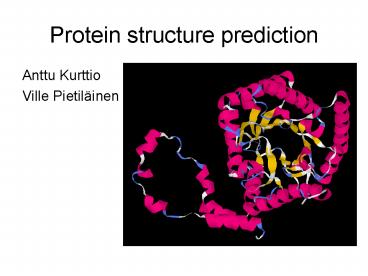Protein structure prediction - PowerPoint PPT Presentation
1 / 14
Title:
Protein structure prediction
Description:
Laws of physics amino-acid sequence = protein structure. Computes potential energy functions. ... Step 4: Open PDB-file. Rejoice! Study your brand new model ... – PowerPoint PPT presentation
Number of Views:111
Avg rating:3.0/5.0
Title: Protein structure prediction
1
Protein structure prediction
- Anttu Kurttio
- Ville Pietiläinen
2
Introduction
- Proteins are one of the most important parts in
any biological systems. - Understanding the folding of the amino-acid chain
to produce functional proteins is essential for
studying cellular systems. - Fast and accessible methods of solving the 3D
structure of a protein are in high demand.
3
Protein structure
- This topic has been covered several times. Next! ?
4
Computational methods
- Ab initio- methods
- Laws of physics amino-acid sequence protein
structure - Computes potential energy functions.
- Minimum potential energy is the most stable
structure and as such the most likely. - Computationally demanding.
5
Comparative methods
- Based on the limited amount of possible tertiary
structure types. - Approximately 2000 different types of protein
folds. - Comparing the sample to a database of known
structures, for example Protein Data Bank.
6
Homology modelling
- Based on the assumption that homologous (related)
proteins fold in a similar fashion. - Folding is a highly conserved factor, much more
so than amino-acid sequence. - Finding a match between two distantly related
proteins can be difficult.
7
Protein threading
- Based on the assumption that similar folding has
already been found. - Comparing parts of the sequence to a database of
known three dimensional structures using a
scoring function. - Works at least somewhat on approximately 80 of
new protein sequences.
8
Programs
- A lot of free programs are available.
- Server based programs do the computational work.
For example Swiss-Model, Rosetta or PSIPRED. - Downloadable applications are used for viewing
the results. For example Swiss-PdbViewer or
Rasmol. - Distributed computing promises increases in
computational capacity.
9
DEMO
- Swiss-Model in four easy steps.
- swissmodel.expasy.org
10
Step 1 Send in the sequence
11
Step 2 Coffee break
12
Step 3 Recieve mail
13
Step 4 Open PDB-file
14
Rejoice!
- Study your brand new model of a protein.
- ?

